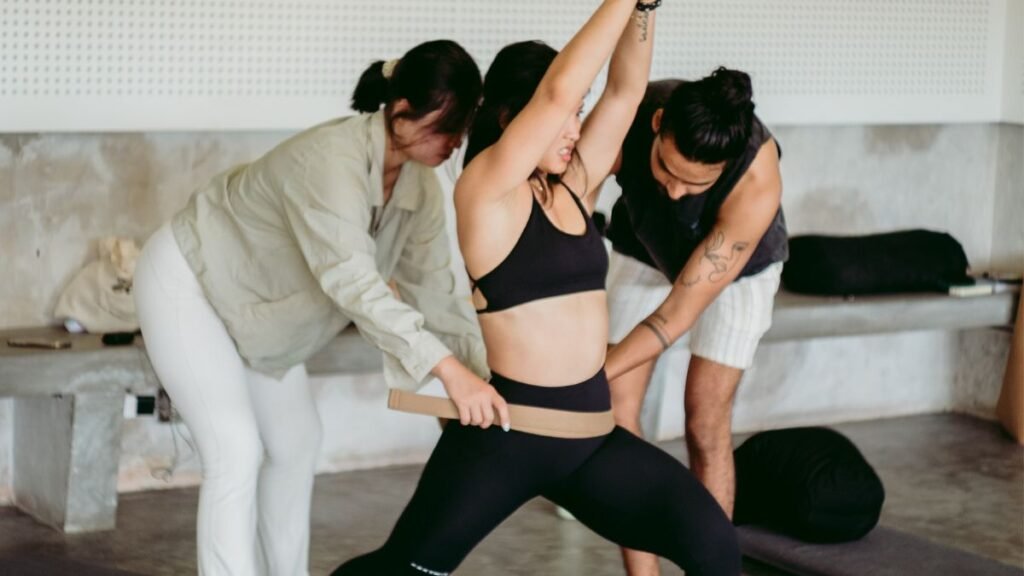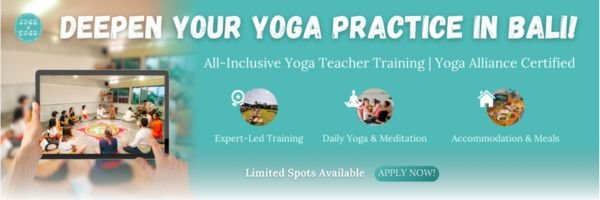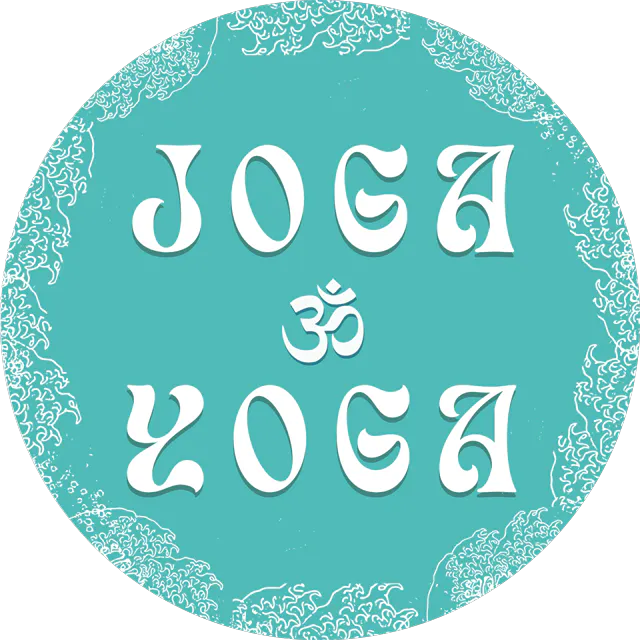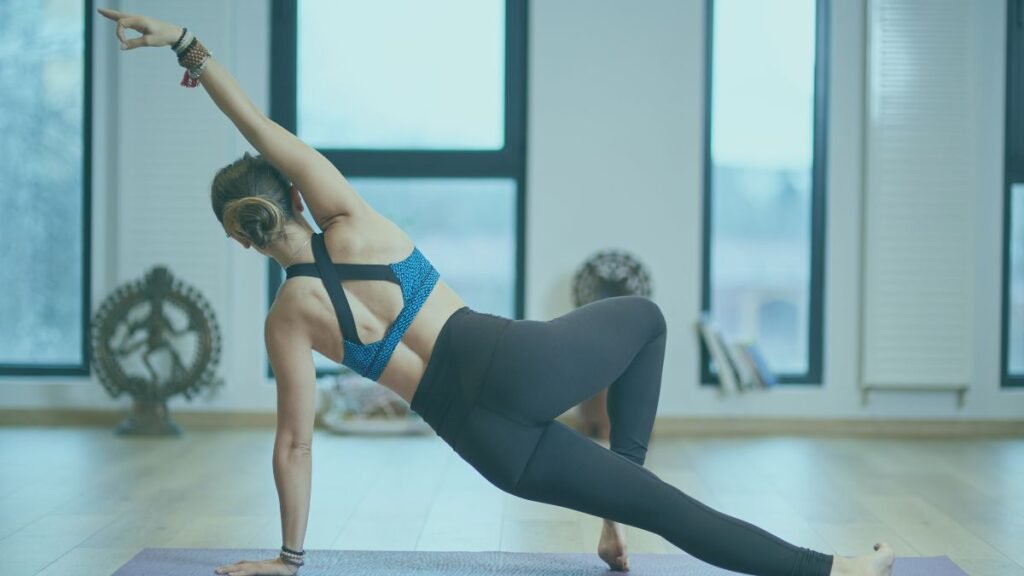Becoming a yoga trainer means more than learning poses. It’s a journey of practice, study, and hands-on teaching. Follow these steps to stay on track:
1. Deepen Your Practice
Commit to your own mat time, mixing breath work, alignment drills, and different styles. Aim for at least four sessions per week over six months.
2. Choose a YTT Program
Pick a Yoga Alliance–registered course. Start with a 200-hour training, then build toward 300 or 500 hours if you wish.
3. Study Core Topics
Learn anatomy, philosophy, sequencing, and class management. Take notes and revisit any areas that feel unclear.
4. Complete Training Hours
Log live calls, self-paced modules, and peer-teaching practice. Stay on track with your program’s hour requirements.
5. Pass the Final Assessments
Prepare for written exams and practical teaching demos. Review your journal, ask mentors for mock tests, and practice cueing clearly.
6. Register (Optional)
Listing as RYT-200 or RYT-500 with Yoga Alliance adds studio credibility. Follow their signup steps and pay the small membership fee.
7. Launch Your Career
Offer free or donation-based classes first. Gather feedback, refine your style, then set your rates and schedule.

Why Choose a Career as a Yoga Trainer?
Teaching yoga offers freedom and purpose. You set your own hours, help others find balance, and build a supportive community. Here are a few reasons people make this move:
1. Flexibility
You set your own hours and choose where to teach—studio, gym, corporate space, or online.
2. Positive Impact
Help students ease stress, improve posture, and build focus through guided classes.
3. Diverse Settings
Teach in various environments—group classes, private sessions, workshops, or retreats.
4. Personal Growth
Boost confidence, empathy, and communication skills as you guide others.
5. Specialization Options
Focus on prenatal, children’s yoga, therapeutic styles, or mindfulness coaching.
Essential Requirements for Aspiring Yoga Trainers
Before you sign up for training, make sure you’ve covered these basics.
Personal practice guidelines
Your own yoga routine sets the stage for teaching. Aim to:
- Practice at least 4× per week for six months or more.
- Mix styles: try Hatha, Vinyasa, Yin, and Restorative.
- Keep a journal of your growth, challenges, and favorite poses.
- Attend live classes to see different teaching methods.
Physical and soft-skill prerequisites
Yoga teaching calls for more than flexibility. You’ll need:
- Anatomy basics: know bones, muscles, and joint safety.
- Clear communication: cue postures in simple, precise language.
- Empathy & patience: adapt to students’ needs and pace.
- Confidence: lead groups, handle questions, and solve hiccups.
- Planning skills: design balanced sequences that flow smoothly.

Choosing the Right Yoga Teacher Training (YTT) Program
200-Hour, 300-Hour, 500-Hour Breakdown
Choosing the right YTT starts with understanding the hours and what they mean for your path.
| Program | Total Hours | Who It’s For |
| 200-Hour | 200 | First-time teachers, solid foundation |
| 300-Hour | 300 | Those who’ve finished 200-Hour |
| 500-Hour | 500 | Full certification (200 + 300 combined) |
Online vs. In-Person Pros & Cons
Decide how you learn best and what fits your life right now.
- Online YTT
- Pros: flexible schedule, rewatch lessons, often lower cost
- Cons: less hands-on feedback, risk of feeling isolated
- Pros: flexible schedule, rewatch lessons, often lower cost
- In-Person YTT
- Pros: live adjustments, instant community, clearer accountability
- Cons: fixed dates, travel, and lodging costs
- Pros: live adjustments, instant community, clearer accountability
Certification & Registration Essentials
RYT-200 vs. RYT-500 vs. E-RYT vs. CYT
Knowing the credential codes helps studios and students trust you.
- RYT-200: completes a 200-Hour course registered with Yoga Alliance.
- RYT-500: combines 200 + 300 hours under Yoga Alliance standards.
- E-RYT: adds 1,000 teaching hours and two years of experience to RYT.
- CYT: “Certified Yoga Teacher” from any recognized body, not limited to Yoga Alliance.
How to Register with Yoga Alliance
- Finish your Yoga Alliance–registered training.
- Gather your certificate details (hours, school name, instructor).
- Create a Yoga Alliance account online.
- Fill in your teaching credentials and upload proof.
- Pay the annual membership fee (usually under $100).
Registration isn’t required by law, but many studios ask for it.
Key Teaching Skills & Safety Basics
Anatomy, Sequencing, Cueing
Building safe, engaging classes means:
- Anatomy: know major muscles and joints to avoid injury.
- Sequencing: plan a clear flow—warm-up, peak poses, cool-down.
- Cueing: use simple language (“inhale arms up,” “soften the knees”) and offer options.
Liability: Insurance and Risk Management
Protect yourself and your students:
- Insurance: carry general liability that covers teaching in studios or online.
- Waivers: have students sign a form acknowledging risks.
- Safe Space: check floors, props, and room setup before each class.
- Continuing Ed: stay current on CPR, first aid, and anatomy refreshers.
Taking these steps cut down stress so you can focus on guiding others.
Gaining Hands-On Experience
Practice Teaching and Peer Feedback
Start by leading short sessions for friends or fellow trainees. Record a 5-minute sequence, then watch it back. Ask peers for two things you did well and one thing to tweak. Trying new cues in a safe space helps you gain confidence.
- Invite a friend to your practice and ask for honest notes.
- Swap teaching slots with a peer so you both get feedback.
- Use a simple feedback form: “What worked?” “What was unclear?”
Finding Mentors and Building Community
A mentor can guide you past common roadblocks. Look for an experienced trainer who shares your values. Join local meet-ups or online groups to swap tips and offers.
- Visit nearby studios and ask teachers about mentoring.
- Join Facebook or WhatsApp groups for yoga trainers.
- Attend workshops or retreats to meet peers and seniors.
Launching Your Yoga Trainer Career
Studio Positions, Online Classes, Corporate Wellness
Studios often hire RYT-200 teachers for drop-in classes. You can also stream live sessions from home on Zoom or Vimeo. Corporate wellness programs pay per hour to lead office yoga breaks.
Setting Rates and Compensation Models
Decide if you’ll charge a flat fee, per drop-in rate, or revenue share. New trainers might start with a low drop-in rate (e.g., $15/class) and raise it as they gain students. For online classes, consider a subscription or bundle of sessions.
Costs, Timeframe & Return on Investment
Typical Training Fees and Living Expenses
Yoga teacher training costs vary by location and format. On top of tuition, factor in lodging, food, and travel.
| Item | Cost Range |
| 200-Hour YTT Tuition | $1,200–$3,000 |
| Lodging (3–4 weeks) | $500–$2,000 |
| Food & Local Transport | $300–$800 |
| Annual Insurance & Registration | $50–$150 |
Expected Timeline from Student to Paid Trainer
Going from student to paid trainer often takes under a year if you stay focused.
- Months 1–6: Build a steady personal practice.
- Months 7–8: Complete your 200-Hour YTT.
- Month 9: Offer free or donation-based classes to build a small roster.
- Months 10–12: Transition to paid classes, adjust your rates, and expand into online or corporate sessions.
Next Steps & Growth Opportunities
Specializations (Prenatal, Children’s, Therapeutic)
- Prenatal Yoga: Learn safe poses for each trimester. Helps new moms stay strong and calm.
- Children’s Yoga: Use games and stories to teach basic poses. Builds focus and fun for ages 4–12.
- Therapeutic Yoga: Study anatomy and rehab techniques. You’ll guide students with injuries or chronic pain.
Advanced Certifications and Continuing Ed
- 300-Hour & 500-Hour YTT: Deepen your skills in philosophy, anatomy, or advanced sequencing.
- Workshops & Retreats: Try short courses on props, adjustments, or meditation.
- CPR/First Aid: Many studios require up-to-date safety training.
- Yoga Therapy or Ayurveda: Add holistic tools to help students beyond the mat.
Why Choose Joga Yoga Teacher Training?

- At Joga Yoga, you’ll learn in an intimate setting led by expert instructors deeply invested in your growth.
- Our courses are Yoga Alliance certified with 100-, 200-, and 300-hour options to match your goals.
- All-inclusive packages include vegan breakfast and lunch, plus dorm, twin-share, or private rooms on campus.
- Class sizes stay small so you get hands-on feedback and individual support.
- You’ll train near Batu Bolong Beach in lush gardens with a pool for practice and rest.
- Sessions are designed around a Hatha-Vinyasa focus with modules on anatomy, philosophy, and teaching methods.
- Flexible dates mean you can join programs like 2–12 June 2025 or pick a 22-night YTT that fits your schedule.
- After graduation, you join a global alumni network with ongoing workshops and mentorship.






